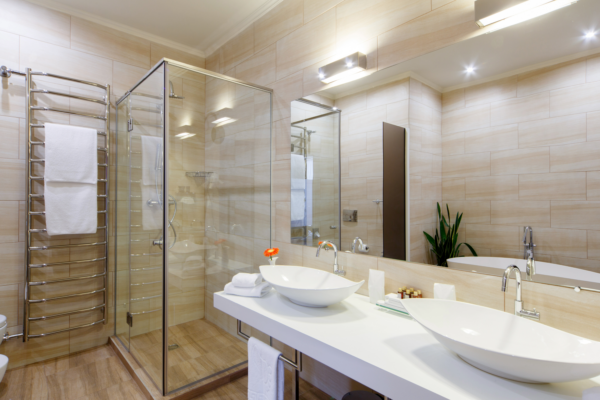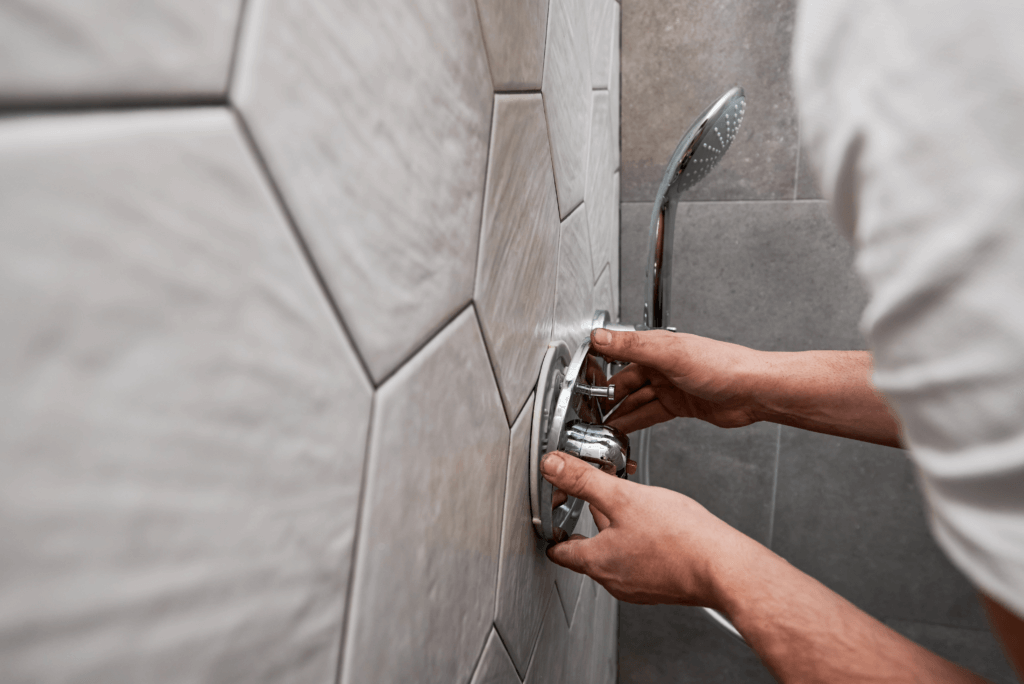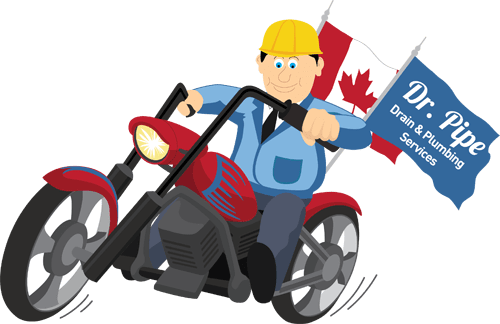
Give us a call today: 613 791 5777 for a free upfront estimate!
Bathrooms are among the most frequently used spaces in any residential, commercial, or industrial setting. Regular maintenance is critical in keeping bathroom plumbing systems functioning smoothly and preventing costly repairs.
This guide is a comprehensive overview of bathroom plumbing maintenance, including key components, common problems, essential tools, and preventative measures.
Components of a Bathroom Plumbing System
Understanding the different components of a bathroom plumbing system is crucial for effective maintenance. Here’s a breakdown of the key players:
Pipes
Common pipe materials include copper, PEX (cross-linked polyethylene), and PVC (polyvinyl chloride).
Copper pipes are known for durability but require soldering for connections. PEX offers flexibility and ease of installation with crimp or clamp connections. PVC is commonly used for drains due to its affordability and chemical resistance.
Vent pipes are another crucial element, allowing air into the drain system to prevent slow drainage and gurgling sounds.
Fixtures
Common fixtures include sinks, toilets, bathtubs, and showers. Each fixture has a shut-off valve, isolating the water supply for maintenance or repairs.
Drains
Drains remove wastewater from the bathroom and typically include a P-trap, which holds some water to prevent sewer gases from entering.
Proper venting is also crucial for efficient drainage and preventing backups.
These components work together to create seamless water flow in and out of the bathroom. Understanding their functions and potential vulnerabilities allows you to perform targeted maintenance and identify potential problems.
Common Bathroom Plumbing Issues
Even with the best systems, problems can arise. Here’s a look at some of the most common bathroom plumbing issues and tips on how to fix them:
1. Dripping Faucets
A persistent drip from a faucet can be annoying and waste precious water. Worn washers or loose packing nuts are frequent culprits of dripping faucets. Replacing washers or tightening the packing nut with an adjustable wrench usually solves the problem.
2. Running Toilets
A toilet that constantly runs is a nuisance and leads to wasted water. A faulty fill valve and a worn flapper in the tank are common causes. Replacing the valve or flapper or adjusting the fill level typically resolves the issue.
3. Slow Drains
Over time, hair, soap scum, and mineral deposits accumulate in drains, leading to slow water drainage. A plunger can often dislodge clogs for minor blockages. However, you might need a drain snake to reach deeper into the pipes for tougher clogs.
Enzymatic drain cleaners can also help break down organic materials that cause clogs.
4. Leaky Pipes
Leaks can occur because of corrosion, loose connections, or damaged pipes. Repairs might involve tightening connections, patching leaks, or replacing damaged pipe sections. Identifying leaks early on can prevent water damage and mold growth.
Essential Tools and Supplies for Maintenance
Having the right tools on hand allows plumbers to tackle routine maintenance tasks efficiently. Here’s what a basic toolbox for bathroom plumbing maintenance should have:
- Adjustable wrenches: These versatile tools tighten or loosen various nuts and fittings on fixtures and shut-off valves.
- Pliers: Pliers help grip and turn objects, such as removing tight nuts or holding pipes during repairs.
- Screwdrivers: Different screwdriver types are necessary for tightening or loosening screws on fixtures and valves.
- Basin wrench: This specialized wrench is for tightening and loosening nuts around sink drains and faucets.
Some plumbing supplies are also important for maintenance, including:
- Replacement washers: Having various faucet washer sizes ensures compatibility with different fixtures.
- Flappers: Replacing worn flappers in toilets can quickly solve running toilet problems.
- Plumber’s tape: This tape provides a watertight seal for pipe connections and helps prevent leaks.
- Drain snake: A drain snake, either manual or powered, can reach deep into drains to remove stubborn clogs.

Step-by-Step Guide to Routine Maintenance Tasks
Regular maintenance prevents minor issues from becoming major problems. Here are some key tasks plumbers can perform during routine bathroom maintenance checks:
Step 1: Checking and Tightening Fixture Connections
Use an adjustable wrench to check for loose connections around shutoff valves, faucets, and showerheads. Tighten any loose connections to prevent leaks.
Step 2: Replacing Faucet Washers and Flappers
Worn washers and flappers are common causes of drips and running toilets. Plumbers can restore proper function to the fixtures by replacing these components with new ones.
Step 3: Cleaning Drains
A plunger can often be the first line of defence for slow drains. For stubborn clogs, you can insert and push down a drain snake into the drain opening to reach the blockage.
As mentioned, you may also use enzymatic drain cleaners, but you must follow the manufacturer’s instructions, which may not be effective for all clogs.
Step 4: Inspecting for Leaks
It is also crucial to regularly inspect pipes, fixtures, and toilet bases for signs of leaks. Look for water stains, dampness, or visible dripping. Early detection of leaks can prevent water damage and mold growth.
Preventing Common Plumbing Problems
Proactive measures can significantly reduce the need for frequent repairs. Here are some preventative tips plumbers can share with their clients:
Tip #1: Install Drain Screens
Drain screens in sinks and tubs can catch hair and debris before entering the drain system, preventing clogs.
Tip #2: Use Appropriate Cleaning Products
Harsh chemicals can damage pipes over time. Recommend using cleaning products specifically formulated for plumbing fixtures.
Tip #3: Avoid Flushing Non-Biodegradable Items
Items like wipes, hygiene products, and cotton swabs should never be flushed down the toilet, as they can contribute to clogs and sewer system backups.
Tip #4: Regularly Inspect for Leaks and Loose Connections
As mentioned earlier, routine inspections can identify minor issues before they become major problems.
Valve Boxes and Their Role in Maintenance
Valve boxes are access points typically located behind walls or under floors where shut-off valves for individual fixtures or the entire bathroom water supply are found. Having readily accessible valve boxes offers several benefits:
- Easier Shut-Off: During repairs or emergencies, readily accessible valves allow plumbers to quickly isolate the water supply to a specific fixture or bathroom, minimizing water damage.
- Protection for Valves: Valve boxes, like the BAC-BTV valve box, shield shut-off valves from accidental damage or getting painted over, ensuring they remain operational when needed.
Signs a Plumbing Issue Requires Professional Attention
While some plumbing issues can be fixed with basic maintenance tasks, others require the expertise of a licensed plumber. Here are some signs that tell you when to call the pros:
- Extensive Leaks: Leaks that cannot be contained with simple tightening or patching require professional assessment to determine the source and best course of repair.
- Clogged Drains that Persist: If a plunger and drain snake fail to clear a clog, it might indicate a deeper blockage in the main drain line, requiring professional tools and expertise.
- Low Water Pressure Throughout the Bathroom: Low water pressure throughout the bathroom could signify a problem with the main water supply line or a pressure regulator issue, requiring professional diagnosis and repair.
- Toilet Malfunctions Beyond Simple Repairs: If a toilet malfunction persists after replacing the flapper or fill valve or the toilet has cracks, consult a plumber to avoid further complications.
- Suspected Damage to Main Pipes or Sewer Lines: Any suspicion of damage to main pipes or sewer lines, such as recurring backups or foul odours, requires immediate attention from a qualified plumber.
Wrapping It Up
Regular maintenance is critical for a functional and efficient bathroom plumbing system. By understanding the components, common problems, and preventative measures, plumbers can effectively maintain these systems and ensure a positive experience for their clients.
With routine checks and timely interventions, you can extend the lifespan of your plumbing infrastructure and avoid the hassle and expense of major repairs. Keeping bathroom plumbing in top shape not only ensures smooth operation but also contributes to the overall comfort and safety of the space.
Give us a call today: 613 791 5777 for a free upfront estimate!




